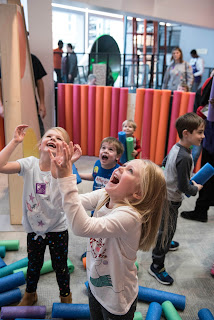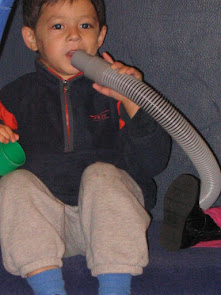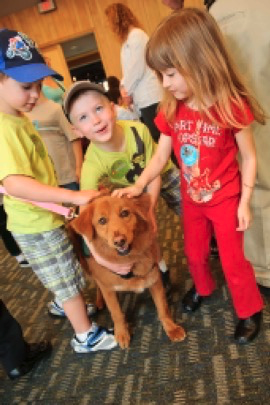 5. Children are naturals at… having wonderful ideas. Often launched with the exultation, Hey, I got an idea! children talk to, play with, and connect with each other through ideas—how to build something, propose a story idea, solve a problem, make up a game, or make something work in a new way. Children are not just consumers of other’s ideas and creativity. Everyday they generate possibilities from what fascinates them, what they wonder about, their knowledge of the world, and their imaginations. There’s joy in the movement of ideas, ideas that build on other suggestions. Children delight in their ideas adding, I know what we can do and Let’s try this.
5. Children are naturals at… having wonderful ideas. Often launched with the exultation, Hey, I got an idea! children talk to, play with, and connect with each other through ideas—how to build something, propose a story idea, solve a problem, make up a game, or make something work in a new way. Children are not just consumers of other’s ideas and creativity. Everyday they generate possibilities from what fascinates them, what they wonder about, their knowledge of the world, and their imaginations. There’s joy in the movement of ideas, ideas that build on other suggestions. Children delight in their ideas adding, I know what we can do and Let’s try this. Museum Notes
Inspiration + Intention + Action by Jeanne Vergeront
Tuesday, November 14, 2023
Nine Things Children Are Great At
 5. Children are naturals at… having wonderful ideas. Often launched with the exultation, Hey, I got an idea! children talk to, play with, and connect with each other through ideas—how to build something, propose a story idea, solve a problem, make up a game, or make something work in a new way. Children are not just consumers of other’s ideas and creativity. Everyday they generate possibilities from what fascinates them, what they wonder about, their knowledge of the world, and their imaginations. There’s joy in the movement of ideas, ideas that build on other suggestions. Children delight in their ideas adding, I know what we can do and Let’s try this.
5. Children are naturals at… having wonderful ideas. Often launched with the exultation, Hey, I got an idea! children talk to, play with, and connect with each other through ideas—how to build something, propose a story idea, solve a problem, make up a game, or make something work in a new way. Children are not just consumers of other’s ideas and creativity. Everyday they generate possibilities from what fascinates them, what they wonder about, their knowledge of the world, and their imaginations. There’s joy in the movement of ideas, ideas that build on other suggestions. Children delight in their ideas adding, I know what we can do and Let’s try this. Monday, July 3, 2023
Seeing Joy: Part 2
.jpg)
Photo credit: WonderTrek Children's Museum
Seeing Joy: Part 2 continues an exploration of what children’s joy looks and sounds like in our museums that I introduced in Seeing Joy: Part 1. Inspired by expressions of joy we see in museums and other settings, Seeing Joy is guided by a collaborative, iterative inquiry process developed with WonderTrek Children’s Museum in Brainerd, Minnesota.
Dedicated tools for each part of the process both guide and document our work. The first tool, Question Worksheet, documents the Working Question, the Invitation to Explore, Methods, Timeline, Take Aways, and Possible Ideas to Revisit.
The Working Question and supporting questions about joy ask:• What conditions appear to encourage and elicit joy?
Importance highlights social emotional learning’s critical role in human development; joy’s importance in children’s lives, fighting stress and pain. It is a form of resilience and feels good.
Joyful Work Arounds
When we got to Invitation to Explore, we encountered a problem. Usually, we would find ways to engage children in exploring the setting, structures, and materials with other children in the PlayLab; observe them; and talk to them about their experiences. Given the spontaneous and ephemeral nature of joy; a lack of a unifying concept around joy; and limitations of the PlayLab space and sessions, that approach wasn’t feasible so early in the process. We also wondered whether asking a 3 or 4-year-old “What is joy?” would be meaningful.
 |
| Photo credit: Tom Bedard |
“Pre-research” was needed to grow our understanding of joy before we could proceed with Invitation to Explore. We chose to explore joy obliquely by investigating it in two familiar contexts: the lived experience of childhood and children’s experiences at other museums. We used four methods.
- Childhood Joy Remembered drew on childhood memories of our team members
- Everyday Joy described moments of joy observed in museums
- Borrowed Set-ups used photos showing joy to study the presence of physical and social conditions related to joy
- Parent Question asked about their child’s joy on WonderTrek’s social media (This had no responses.)
We were all children once and experienced joy in our childhoods. Sometimes there was more joy and other times less. Bernard Berenson, a 20th century American Art Historian, recalls a moment in his childhood that tells us something about experiencing joy.
“… In childhood and boyhood this ecstasy overtook me when I was happy out of doors. Was I five or six? Certainly not seven. It was a morning in early summer. A silver haze shimmered and trembled over the lime trees. The air was laden with their fragrance. The temperature was like a caress. I remember—I need not recall—that I climbed up a tree stump and had no need for words. ‘It’ and I were one.”
Members of the WonderTrek Project Team were asked to recall a memory of joy from their childhoods, a moment of joy when they were a child, any age up through 10 or 12 years; to explore that memory, plumb the feel and source of it. They shared what they’d been feeling and doing; where they were; who was with them. Memories that they, other colleagues and friends have shared about remembered childhood joy include being outdoors, in nature, a sense of freedom, sensory experience, immersion.
- Crawling through and disappearing into the tall grass
- Going out horseback riding with my dad early in the morning in late summer
- Climbing on the bus and going to the library by myself to get books
- Riding my bike wearing a freshly ironed shirt my mother made. It was a perfect moment; I felt free
- Floating in the lake with my sisters
- Laying in the grass under trees with light coming through the leaves. All the flickering lights reminded me of a million candles
 |
| Photo credit: Vergeront |
- The child’s facial expressions: body language, tone, sensory qualities of objects and materials
- What might the child be feeling?
- What qualities of joy do we think are expressed?
- Joy is a positive emotion that can be experienced with other emotions, such as sorrow, at the same time
- Joy often brings a feeling of connection – to others, to ourselves, to nature, to something greater
- There is contentment and satisfaction
- A feeling of joy ranges from a peaceful contentment to exuberance
- It is ineffable, brief, fleeting
- Joy happens in everyday moments
Borrowed Set-ups
 |
| Photo Credit: Bruce Slicox. Courtesy of Minnesota Children's Museum |
• Open space
• Natural light
• Objects that are soft, plentiful, accessible, unusual in this context
• Falling objects in mid-air … surprise and unpredictability in how they fall
• Visibility into what’s happening overhead
• Space for several children
Gathering a few clues from one Borrowed Set-up at a time, we glimpsed what invites joy. Asking ourselves, what we were seeing, we started building Play Conditions disposed towards joy. What are Play Conditions? They are features of the physical and social environment that support and encourage children’s exploration, play, and learning. These conditions emerge from what research, child development, play theory and children’s museum practices indicate encourage and support children’s engagement, and maybe their joy. This is not a causal relationship between Play Conditions and more joy. But we all carry assumptions, hunches, and mini-theories about what we think is likely to encourage some types of interactions more than others. In this inquiry, Play Conditions help us think about creating experiences and environments disposed towards joy.
Qualities associated with joy that surfaced in childhood memories and observations fall into WonderTrek’s 7 Play Conditions.
• Image of the Child, children’s strengths and capabilities: expressions of joy accompany a
strong sense of agency and sense of self
• Context or setting, the qualities of the physical and social space: the soft qualities of space: abundant light, natural light, moving air; sensory immersion; and space for moving freely.
• An Invitation to Explore encourages children’s engagement or piques their curiosity: with surprise, novelty, or enticing sensory patterns.
• Materials seed the set up with possibilities that are: explorable, unscripted; responsive to children’s actions
• Interactions and Relationships connect people: children feel recognized and connected to others; and adults are sensitive to children’s spark
• Content, or what is fascinating and meaningful to children: the wind, water, animals; movement, nature
• Time creates openings for joy: unstructured time, a sense of possibilities and freedom
What We’re Learning
 |
| Photo credit: Vergeront |
• A feeling and an experience often shared with others, that happens everyday
• Even very young children express joy
• Joy’s qualities and expressions take many forms: wonder, surprise, exuberance, a feeling of immensity and connection
• Joy and play are closely related
• Museums are places for joy
• Experiencing joy matters in children’s lives. It may not matter whether we remember childhood joy; it does matter that we have experienced joy as children
We’re learning from the WTI process itself.
• Bringing in a child’s perspective shows us what we might not otherwise notice
• Play-and activity-based methods allow children’s fuller participation
• The process is flexible, adaptable to various questions and contexts
• Questions matter
• We are making meaning a bit at a time
This collaborative effort has been made possible by a wonderful team. Thank you, Peter Olson, Cheryl Kessler, Mary Weiland, Jim Roe, Shannon Wheeler, Emilee Maillot.
Sunday, June 4, 2023
Seeing Joy: Part 1
- We say… “Children play for the sheer joy of it.”
- We highlight “joyful play” and “joyful learning” on social media
- Our missions aspire to:
- … bring the joy of learning and wonders of the natural world to life
- … create unparalleled experiences to inspire excellence and a lifelong joy of learning
- A dose of joy boosts our immune systems, and fights stress and pain
- Positive emotions like joy and excitement powerfully impact physical and mental health over the whole lifespan
- Joy is a form of resilience: moments of joy can help our bodies recover from the physiological effects of stress
These benefits get at why joy matters. And then there’s this:
"Joy, particularly through the activities that result from feeling joy, provides the individual with the opportunity to learn new cognitive and behavioral skills and forge new social relationships and skills which enhances resilience to future obstacles and threats." (1)
If joy is important and we want to grow its presence in our museums, we need to be attentive and attuned to children’s experiencing it; to reflect on their expressions of joy; notice conditions that might have sparked joy; and invite joy in.
Learning About Joy in Children’s Lives and Our Museums
For several years I have been working with WonderTrek Children’s Museum an emerging museum in Brainerd, MN. Our planning work includes co-developing a collaborative inquiry process for exploring how children direct their play.
As part of this, I’ve been exploring joy. The museum’s mission includes, The joy of play and the wonder of learning and Experiencing joy is among a set of essential experiences in WonderTrek's learning experience framework. A site has been secured and a new building is being designed. WonderTrek believes it’s not too early in the process of opening a strong regional museum to use a research-and learning approach in:
- planning experiences at a temporary 900 s.f. PlayLab
- offering activities at locations across the region’s 5 counties
- developing exhibit concepts and design
- growing WonderTrek’s Center for Play and Interactive Learning
WonderTrek’s project team has developed a collaborative, iterative inquiry process that actively engages children and adults including staff and consultants. We use a variety of methods to investigate and document roomy questions around children’s play, exploration, and learning; the role of the environment and materials; and how they understand place.
Tuesday, May 2, 2023
MUSEUM NOTES
- Learning frameworks are both becoming an established practice and are evolving.
- There’s variety among learning frameworks from one museum to another.
- Learning frameworks are developed by museums at all stages of development, from emerging museums to ones that are expanding or reinventing themselves; or doing some backfill on their learning focus.
- And interestingly enough, I think children’s museums are leading the way among museums in developing, using, and advancing learning frameworks. What is a learning framework?
- foundational set of ideas grounded in its vision, mission, values, and audience
- resting on research and conceptual foundations around children’s growth and development, their play and learning, and their futures
- and is developed collaboratively.
 |
| Mud is quintessentially interdisciplinary |
Wednesday, November 2, 2022
Play Conditions: A Framework
MUSEUM NOTES
 |
Photocredit: Vergeront (MIA) |
 |
| Photo credit: Vergeront (CMOM) |
- Image of the Child is about the child’s strengths and capabilities and means engaging children at their highest level of ability; and making their strengths and capabilities visible.
- Valued qualities are: children’s curiosity, capabilities, social disposition, caring and empathy
- Possibilities that support and reflect the child’s capabilities: choices for one child and different choices for different children; traces of children’s thinking, doing, and making; focus on shared interests, etc.
- Context or Setting is about both physical and social space, ranging from macro to micro, where children can explore, play, and learn.
- Valued qualities are: safe, welcoming and accessible settings
- Possibilities for shaping settings: different scales, large and small spaces; light and sound; recognizable features; wayfinding clues; edges that define and differentiate areas, etc.
- Invitation to Explore is about arranging selected elements to provoke or encourage children to notice and wonder, explore ideas—without giving too much direction.
- Valued qualities are: sparking curiosity; the child taking the experience where it needs to go; offering something worth noticing and discovering
- Possibilities for encouraging exploration: something fascinating; questions incongruities; multiple provocations; a sound walk, etc.
- Materials and Objects is about loose parts, tools, phenomena, art materials, digital media, etc. that give children agency and choice; encourage exploration and experimentation that is physical, social, emotional, cognitive, and linguistic; that generate new possibilities; and reveal new perspectives and insights about the world.
- Valued qualities are materials that support children’s agency, promote noticing and wondering; change with use and generate new insights; work at multiple ages
- Possibilities for materials: engage some and sometimes all the senses; are real stuff; can be carried, lined up, and moved; change with use, etc.
- Relationships is about children and adults engaging with others; feeling a sense of
welcome, respect, and connection
Photo credit: Vergeront (Madison Children's Museum) - Valued qualities foster social connections, value the individual and the group, are collaborative
- Possibilities for connecting: exchanging ideas among children; scaffolding; conversation; multiple places and positions, roles or seating, etc.
- Content is based in children’s interests and what is fascinating and meaningful to them about the world
- Valued qualities are interdisciplinary content; implicit content from child development; meaningful connections for the child
- Possibilities for engaging with content: comes through the senses, is embedded in the world, is released through interactions, can be experienced from different points of view, etc.
- Time is about a sense of open and unregulated play; time to direct play, follow an activity to a satisfying moment, and find enjoyment
- Valued qualities are children deciding when play starts and ends; play stretching out over time
- Possibilities for opening up time come from discouraging distractions and interruptions; allowing experiences to come to a natural end
 |
| Photo credit: Jim Roe (SMM) |
 |
| Photo credit: Snarkitecture |
at play in varied settings, we have new hunches, generate possibilities, find fresh combinations, and ask another “what if?” question. We begin to discover, and hypothesize about, connections between the presence of certain features and children’s play. We build theories—temporary explanations—that express what might happen when particular qualities or variables of the physical and social environment are brought together. These hypotheses and mini-theories about places for play help us keep track of this world we are creating with children for play.













